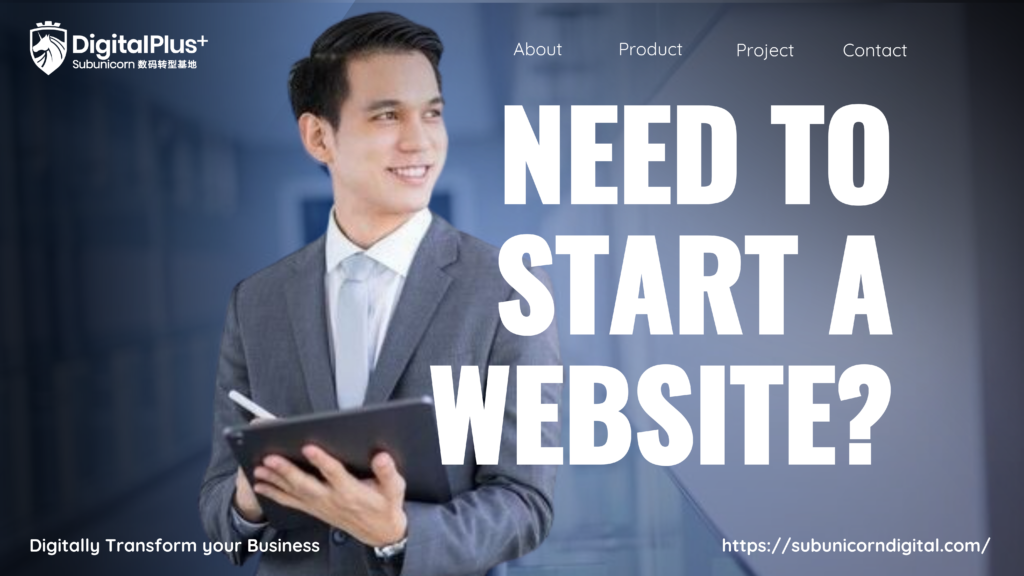Starting a website can seem like a daunting task, but with the right tools and a clear plan, it’s easier than you think. Whether you’re creating a personal blog, a business site, or an online store, here’s a step-by-step guide to help you get started.
1. Define Your Website’s Purpose
The first step in creating a website is to clearly define its purpose. Ask yourself the following questions:
• WHAT: What do you want to achieve with your website?
• WHO: Who is your target audience?
• TYPE: What type of content will you be sharing?
Understanding the purpose of your website will guide you through the rest of the process and help you make informed decisions.
2. Choose a Domain Name
Your domain name is your website’s address on the internet. It should be:
• Memorable: Easy to spell and remember.
• Relevant: Reflective of your brand or the content you’re offering.
• Unique: Not easily confused with other sites.
You can register your domain through various registrars like GoDaddy, Namecheap, or Google Domains.
3. Select a Web Hosting Provider
Web hosting is the service that allows your website to be accessible on the internet. There are different types of hosting to consider:
• Shared Hosting: Cost-effective and suitable for small websites.
• VPS Hosting: Provides more resources and flexibility.
• Dedicated Hosting: Offers the most control and resources, ideal for large websites with high traffic.
Popular hosting providers include Bluehost, SiteGround, and HostGator. Choose a provider based on your needs and budget.
4. Choose a Content Management System (CMS)
A CMS makes it easy to manage your website’s content. The most popular CMS is WordPress, known for its flexibility and extensive plugin ecosystem.
Other options include:
• Drupal: For more complex sites requiring extensive customization.
• Joomla: For users who need flexibility and advanced features.
• Wix or Squarespace: For beginners who prefer a simple drag-and-drop interface.
5. Design Your Website
The design of your website should be:
• User-Friendly: Easy to navigate.
• Responsive: Looks good on all devices.
• Reflective of Your Brand: Consistent with your brand’s color scheme and style.
If you’re using WordPress, you can choose from thousands of free and premium themes. Customize your chosen theme to align with your brand’s identity.
6. Create Quality Content
Content is the heart of your website. It should be:
• Relevant: Useful and interesting to your target audience.
• Engaging: Well-written and visually appealing.
• SEO-Friendly: Optimized for search engines to improve visibility.
Regularly update your site with fresh content to keep visitors engaged and attract new ones.
7. Add Essential Featuresent
Enhance your website’s functionality with essential features such as:
• Contact Forms: To allow visitors to reach out to you.
• Social Media Integration: To connect with your audience on various platforms.
• E-commerce Capabilities: If you’re selling products or services online.
• Security Measures: Such as SSL certificates to protect user data.
Plugins and extensions can help you add these features easily.
8. Test Your Website
Before launching, thoroughly test your website to ensure everything works correctly.
Check:
• Cross-Browser Compatibility: Your site should function well on all major browsers.
• Responsive Design: Ensure your site looks good on mobile devices.
• Functionality: Test all links, forms, and interactive elements.
Tools like Google’s Mobile-Friendly Test and BrowserStack can help you with this process.
9. Launch Your Website
Once you’re satisfied with the design and functionality, it’s time to launch your website. Announce your launch on social media and other channels to attract visitors. Monitor your site’s performance and gather feedback to make improvements.
10. Maintain and Update Your Website
Creating a website is just the beginning. Regular maintenance is crucial to keep it running smoothly and securely.
This includes:
• Updating Content: Regularly add new content to keep your site fresh and relevant.
• Updating Software: Keep your CMS, plugins, and themes up to date.
• Monitoring Performance: Use analytics tools to track visitor behavior and optimize accordingly.
Starting a website involves several key steps, from defining your purpose to ongoing maintenance. By following this guide, you can create a professional and effective website that meets your goals and engages your audience. Embrace the journey of building your online presence, and enjoy the opportunities it brings!
Ready to get started? Begin with choosing a domain name and web hosting provider, and you’re well on your way to launching your very own website. Happy building!
At Subunicorn Digital Plus, we specialize in guiding businesses through their digital transformation journey. Our expertise lies in delivering customized, cloud-based solutions that streamline operations, enhance decision-making, and drive growth. We understand that each business is unique, and our tailored approach ensures that our clients receive the solutions that best meet their specific needs.
Our goal is to ensure that businesses keep pace with technological advancements and thrive in the digital age. By partnering with Subunicorn Digital Plus, you gain access to a team of experts dedicated to helping you achieve operational excellence, foster innovation, and stay competitive in an ever-changing market.
Websites enhance visibility, credibility, and customer reach. They are essential for modern marketing and communication.
The cost of making a website varies widely, from a few hundred to several thousand dollars. Factors include design complexity, functionality, and developer rates. Generally, expect to spend between $500 and $10,000.
You may build your own website if you have the skills and time. Otherwise, paying a professional ensures quality and saves time. Consider your budget and technical
Upgrading a website can cost anywhere from $200 to several thousand dollars. The cost depends on the complexity of updates and the developer’s rates. Plan for both design and functional improvements.
Yes, it’s possible to make a free website using platforms like Wix or WordPress. However, free options often have limitations and may include ads. For a professional look, consider paid plans.
To buy a domain name, choose a registrar like GoDaddy or Namecheap, search for your desired domain, and follow the registration process. You’ll need to pay an annual fee to maintain ownership.





